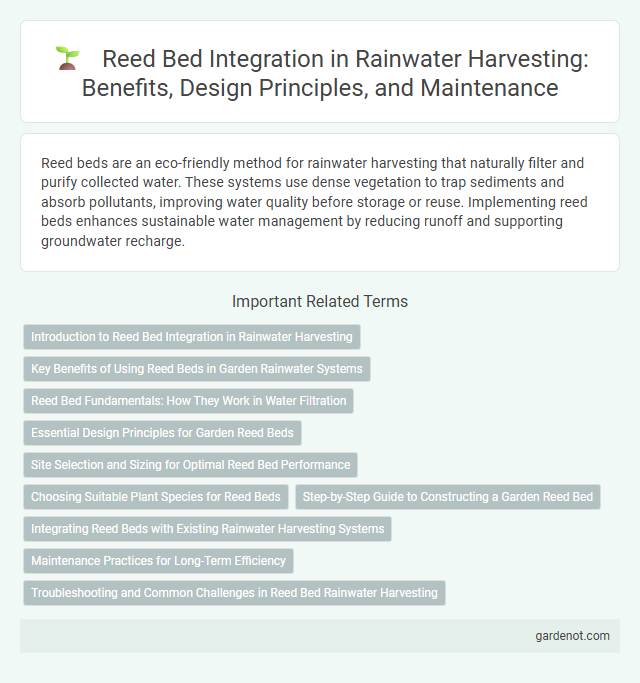Reed beds are an eco-friendly method for rainwater harvesting that naturally filter and purify collected water. These systems use dense vegetation to trap sediments and absorb pollutants, improving water quality before storage or reuse. Implementing reed beds enhances sustainable water management by reducing runoff and supporting groundwater recharge.
Introduction to Reed Bed Integration in Rainwater Harvesting
Reed bed systems offer an eco-friendly solution for enhancing rainwater harvesting by naturally filtering and purifying collected water through wetland vegetation. These constructed wetlands utilize reeds such as Phragmites australis to remove contaminants, improve water quality, and support sustainable water management. Integrating reed beds into rainwater harvesting frameworks promotes biodiversity while reducing reliance on chemical treatments and minimizing environmental impact.
Key Benefits of Using Reed Beds in Garden Rainwater Systems
Reed beds in garden rainwater systems provide natural filtration by removing pollutants and nutrients from harvested water, enhancing water quality for irrigation. They support biodiversity by creating habitats for beneficial insects and microorganisms, contributing to a balanced garden ecosystem. Reed beds also promote sustainable water management by reducing runoff and improving groundwater recharge, making them an eco-friendly solution for rainwater harvesting.
Reed Bed Fundamentals: How They Work in Water Filtration
Reed beds utilize natural processes involving Phragmites australis to filter contaminants from rainwater through physical, chemical, and biological mechanisms. Microorganisms attached to the reed roots break down pollutants, while sedimentation traps suspended solids, enhancing water clarity. This eco-friendly system effectively improves water quality by reducing nutrients, heavy metals, and pathogens before the water is reused or discharged.
Essential Design Principles for Garden Reed Beds
Effective garden reed bed design for rainwater harvesting requires careful selection of appropriate wetland plants such as Phragmites australis and Typha latifolia to maximize water filtration and nutrient uptake. The substrate must consist of layers of gravel and sand to ensure proper drainage and prevent root waterlogging, optimizing microbial activity for contaminant breakdown. Proper hydraulic loading rates and bed slope are critical to maintaining water retention time, enhancing pollutant removal efficiency in the constructed reed bed system.
Site Selection and Sizing for Optimal Reed Bed Performance
Site selection for reed bed systems requires assessing soil permeability, groundwater levels, and proximity to pollution sources to ensure effective wastewater treatment and prevent contamination. Proper sizing depends on influent volume, pollutant load, and retention time, typically calculated using hydraulic loading rate and organic loading rate parameters. Optimal reed bed performance is achieved by balancing these factors to maximize nutrient removal and maintain system longevity.
Choosing Suitable Plant Species for Reed Beds
Selecting appropriate plant species for reed beds centers on the natural adaptability of Phragmites australis, commonly known as common reed, due to its high efficiency in nutrient uptake and pollutant removal. Carex, Typha, and Schoenoplectus species also thrive in varying water depths and contribute to enhanced contaminant filtration. Optimal plant choices improve water retention, biological treatment processes, and overall system sustainability in rainwater harvesting applications.
Step-by-Step Guide to Constructing a Garden Reed Bed
Constructing a garden reed bed begins with selecting a suitable location that receives ample sunlight and has well-drained soil. Excavation follows, creating a shallow basin lined with impermeable material to prevent water seepage, then layered with gravel and sand for filtration. Planting native reed species such as Phragmites australis enhances water purification by naturally filtering pollutants and promoting healthy microbial activity.
Integrating Reed Beds with Existing Rainwater Harvesting Systems
Reed beds enhance rainwater harvesting systems by naturally filtering and purifying collected water through biofiltration processes, improving water quality before storage or reuse. Integrating reed bed systems with rainwater catchment facilities reduces sediment and nutrient loads, promoting sustainable water management and reducing the need for chemical treatments. Their incorporation supports eco-friendly water recycling, benefiting irrigation, groundwater recharge, and maintaining local biodiversity.
Maintenance Practices for Long-Term Efficiency
Reed bed maintenance for rainwater harvesting involves routine inspection to prevent clogging and ensure effective filtration, focusing on removing accumulated debris and sediment. Regularly trimming reed growth maintains optimal water flow and nutrient uptake, which supports microbial activity essential for pollutant breakdown. Monitoring water levels and soil moisture helps sustain the reed bed's ecological balance, enhancing its efficiency and longevity in natural wastewater treatment.
Troubleshooting and Common Challenges in Reed Bed Rainwater Harvesting
Reed bed systems in rainwater harvesting often face clogging due to sediment accumulation and root overgrowth, which impede water flow and reduce filtration efficiency. Regular maintenance involving sediment removal and careful management of plant density helps prevent anaerobic conditions and foul odors. Monitoring nutrient levels and ensuring proper hydraulic loading rates are critical to avoid system failure and maintain optimal biofiltration performance.
Reed bed Infographic

 gardenot.com
gardenot.com